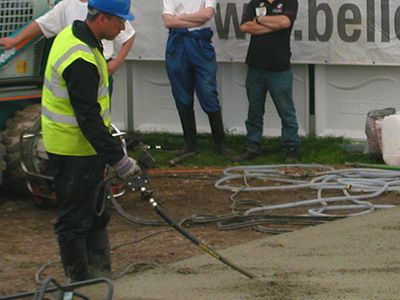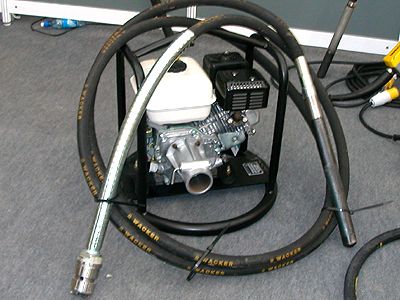Page 1 of 1
Posted: Sat Sep 11, 2004 9:08 am
by Andrew in Melb2
Hi,
I'm an amateur, as proven by previous posts. I need to pave up to the edge of a new square pond (not dug yet). My thoughts on the process are:
1. Put together a frame of railway sleepers (inside of frame to equal size of the pond).
2. Dig out the pond to a depth deep enough for the frame
3. Embed the frame in the ground
4. Compact ground around the pond, including roadbase. Roadbase <b>not</b> to cover frame.
5. Dig out the rest of the pond, place rubber liner inside
6. Use bedding sand everywhere else, but on top of the frame use concrete.
7. Lay pavers directly onto un-set concrete, slightly over-hanging pond.
This is just my own inexperienced reasoning, so please destroy my theory! Main problems are that I need to compact the soil without caving in the pond (therefore compact it before the full pond is full), and I need the edge to be robust enough to hold the heavy pavers, and not cave in as someone is standing on it (therefore the sleeper frame).
Thanks,
Andrew
Posted: Sat Sep 11, 2004 10:13 am
by 84-1093879891
I wouldn't use sleepers. There's a good chance that one or more of them will 'drop' either when the pond is being constructed) because of all the earth being removed) or after the pond is filled. What I'd use is a ring beam.
This is essentially the same idea as the sleepers, but it's cast in concrete, rather than built from timber. The whole thing can be reinforced and the benefit is that, if there is any minior ground movement, the beam as a whole remains stable (ish).
So, you'd dig a trench for the ring beam outside the perimeter of the planned pond. It needs to be at least 300mm wide and 300mm deep, but you can make it any size larger than that. The trench is then lined with a damp proof membrane - in Britain/Ireland we use a product known as PIFA 1200, which means a 1200 micron thick sheet of polythene.
Next, install the reinforcing. 4 horizontal bars should do the job - 2 top, 2 bottom, with a minimum of 50mm cover (see Reinforcing page.)
Once that's in place, the concrete can be poured - you'll need a mix with a 28 day strength of around 30 N/mm² - I'm not sure how this is described in your country, but over here we call it a C30 mix. The concrete needs to be vibrated once it's in the trench, but no need to go to lots of trouble finishing the top: in fact, the rough'n'ready untrowelled finish is ideal for the later stages.
Leave the ring beam for 5 days before doing owt else, and then you can do the ground compaction as required, and dig out the pond itself, taking care not to undermine the ring beam.
Place your pond liner on a bed of soft sand and lap it up over a carefully prepared bed of strengthened mporat laid atop the rig beam. The pavers that are to form the edge of the pond should be bedded on the same strengthened mortar (use SBR or Ronafix if it's available over there) in a manner that 'traps' the membrane between the two mortar layers.
Does all this make sense?
Edited By TonyMcC on 1094894057
Posted: Sat Sep 11, 2004 12:38 pm
by Andrew in Melb2
Thanks - I think I got most of that. One thing:
"concrete needs to be vibrated": we have vibrators over here (Australia), and vibrating plate compactors - is this what you mean (to use one of those)? While it is setting?
Also, should the ring be as deep (or even deeper) as the pond itself? Otherwise I would think I might cause the ring to drop while I was excavating.
cheers,
Andrew
Posted: Sat Sep 11, 2004 7:51 pm
by ABILITY
Agree with Alan, would not recommend using sleepers.
We usually try and transmit load from edge slabs to base of pool.
Thus excervate first, cast a concrete base slab, or strip footing around edge, then build up sides to ground level in concrete block - either soilds, or hollows with reinforcing rod and concrete in-fill, depending on scale and depth of wall required.
Back fill around wall and compact in layers to ground level.
Line base with sand and sides with underlay prior to installing liner. Or you could use a waterproof render, or fibreglass sealer instead of liner.
Ensure top is very level, to allow slabs to be bedded on top of liner, pinching it in place, as Alan describes, with an over hang to hide liner top.
Allow for an overflow just below slab level.
We see so many pools with not just unsightly, but unsafe edge slabs, build on the soil around the pool, as described in many books etc.
Is it Alan, or Tony who has answered ??
Posted: Sun Sep 12, 2004 11:16 am
by Andrew in Melb2
Thanks Ability, starting to get it straight in my head. Could you please clarify what you mean by 'allow for an overflow just below slab level'?
Also, when you mention solid blocks, how would they stay in place? I guess you'd mortar them in like bricks?
Thinking of drainage, i.e. so that water doesn't flow into the pond, shouldn't the slabs over the edge be just slightly angled down towards the outside?
Hmmm, the less ignorant I get, the bigger this project becomes!
cheers,
Andrew
Posted: Thu Sep 16, 2004 12:48 pm
by 84-1093879891
A vibrating poker for concrete is a special tool than causes no end of sniggers from the Apprentices. It's basically a long, flexible shaft with a steel head that's between 25-75mm in diameter. It's attached to a drive unit and then it vibrates with some force. It is inserted into the freshly-placed plastic concrete to drive out any air pockets and to ensure full compaction of the material.
Here's a couple of pictures...


....let's not bother with any smutty remarks - we've heard them all before! 
Posted: Sat Sep 18, 2004 7:25 am
by Andrew in Melb2
consider it thought of, but not said . . . thanks.

